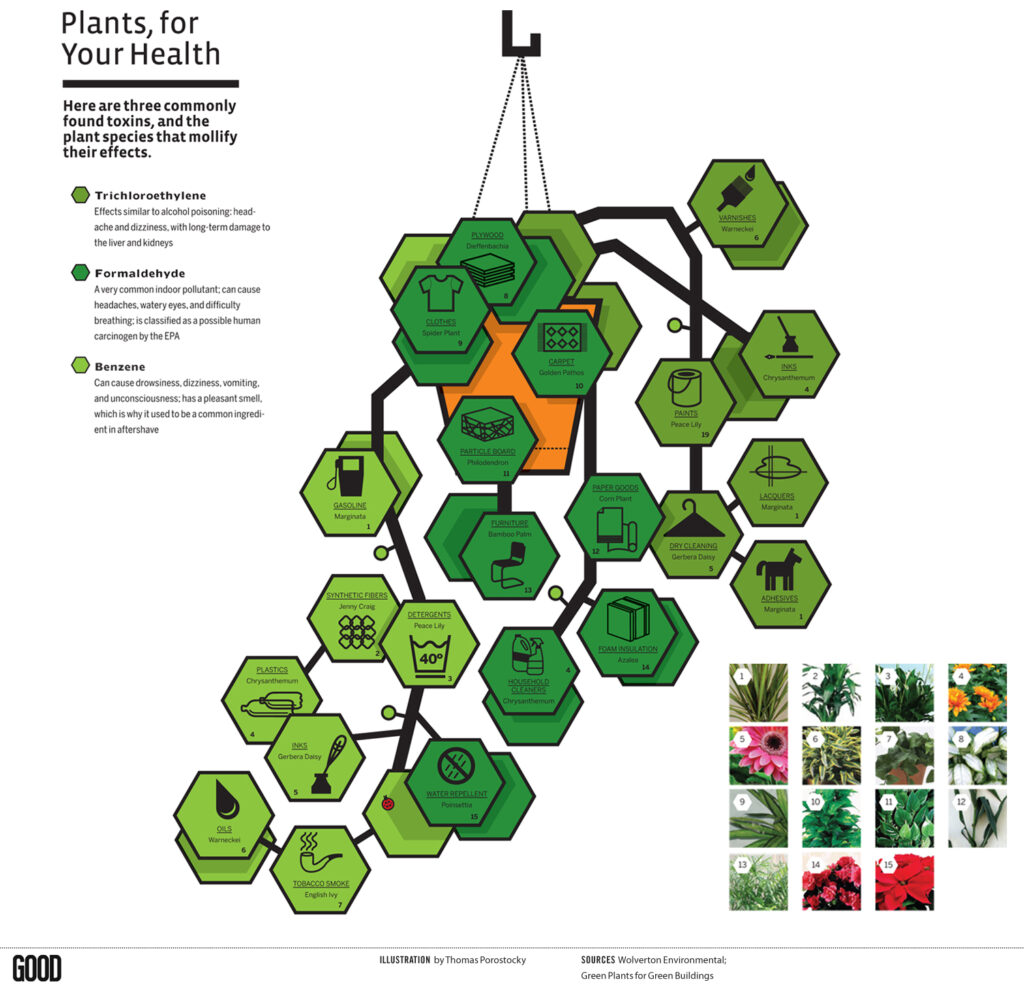
Money Plant (Epipremnum aureum)
I’ve been reading a lot lately about air filtering house plants and which ones are the best for the job. Turns out, most are specialized to remove specific toxins, so lets first look at the list of indoor toxins so we can find out which plants you need to remove those toxins. Pretty much all plants are going to improve air quality, these have just been researched more than others and/or are better performing at removing certain things. Also keep in mind that many of these are also invasive weeds, so please keep them in pots in your home and take care when disposing of them.
Trichloroethylene (TCE) in the home is introduced from dry cleaning, printing inks, paints, lacquers, varnishes, and adhesives. This chemical is considered by the National Cancer Institute as a potent liver carcinogen.
Benzene is present in many common items including gasoline, inks, oils, paints, plastics, and rubber. It is an eye and skin irritant as well as being a contributing factor to leukemia in humans. Repeated skin contact with benzene will cause drying, inflammation, blistering and dermatitis.
Formaldehyde is a extraordinarily common in almost every indoor environment. Found in everything from particle board or pressed wood products used in many furniture pieces, to grocery bags, facial tissues and paper towels. Even common household cleaning agents and air fragrances contain formaldehyde. With carpet backings, fire proof coatings, permanent-press clothes and natural gas all containing the toxin, it is nearly impossible to avoid.
Side effects from formaldehyde exposure include irritation to the eyes, nose and throat, headaches, and in some cases asthma. The Environmental Protection Agency (EPA) has recently conducted research which has caused formaldehyde to be strongly suspected of causing a rare type of throat cancer in long-term occupants of mobile homes.

Areca Palm (Chrysalidocarpus lutescens)
Areca Palm (Chrysalidocarpus lutescens)
- Good air humidifier (a 6 foot plam can release 1L of water a day)
- Good at removing ammonia and formaldehyde
Mother-in-law’s Tongue (Sansevieria trifasciata)
- Very effective at removing formaldehyde and benzene
- converts CO2 to O2 at night
Green Spider Plant (Chlorophytum comosum)
Money Plant (Epipremnum aureum)
- Removes formaldehyde and other VOCs
- Easy to care for and fast growing
English Ivy (Hedera Helix)
- Good for allergies
- Removes Airborne Mold and feces (After 12 hours in a room, it can remove up to 78 percent of airborne mold and 94 percent of airborne feces)

Peace Lily (Spathiphyllum)
Gerbera daisy (Gerbera jamesonii)
Chrysanthemums (Chrysantheium)
Peace Lily (Spathiphyllum)
- Beautiful flowering plants
- Good at removing Acetone
- Good at removing Trichloroethylene benzene
TOP 10 plants most effective in removing Formaldehyde, Benzene, and Carbon Monoxide from the air:
- Bamboo Palm (Chamaedorea Seifritzii)
- Chinese Evergreen (Aglaonema Modestum)
- English Ivy (Hedera Helix)
- Gerbera Daisy (Gerbera Jamesonii)
- Dracaena (Dracaena)
- Mass cane/Corn Plant (Dracaena Massangeana)
- Mother-in-Law’s Tongue (Sansevieria Laurentii)
- Pot Mum (Chrysantheium morifolium)
- Peace Lily (Spathiphyllum)
- Warneckii – Dracaena “Warneckii”)

Mother-in-Law’s Tongue (Sansevieria Laurentii)
Purple Waffle Plant
Asparagus fern
Rubber Plant
Weeping Fig
Golden Pothos
Philodendron
Results based on studies by Stanley J. Kays of the Department of Horticulture, University of Georgia – studies on phytoremediation;
Kamal Meattle’s 15 year Indoor pollution studies at the at Paharpur Business Centre in Dehli;
NASA and the Associated Landscape Contractors of America (ALCA) Sick Building Syndrome pollution-absorbing studies.
Resources:
http://www.mnn.com/the-home/gardening-landscaping/stories/can-houseplants-save-your-life
http://greenupgrader.com/6600/green-plants-for-fresh-air/
http://greenupgrader.com/1408/plants-for-health-improve-your-indoor-air-quality/
http://www.treehugger.com/files/2007/08/science_museum.php
http://www.zone10.com/nasa-study-house-plants-clean-air.html
http://awesome.good.is/marketplace/010/010plants_for_health.html
http://www.webmd.com/allergies/news/20051107/english-ivy-fix-allergies

Comments 5
Pingback: Winterize your Home for Energy Efficiency | The Chic Ecologist
Pingback: Eco Tips for Mom | The Chic Ecologist
Pingback: Millenium Marketer › Say Yes to Brussels Sprouts
How many plants will I need per square foot to effectivly remove toxins from my home?
Author
Hey Lenslee,
I think the more, the better, but according to Meattle’s ratio, the 15 year Paharpur Business Centre study founder, 1 plant per 30 to 50 square feet is very effective.
Just one plant will make a difference, so decorate according to your taste, just try and incorperate as many as possible.
Good Luck Lenslee!